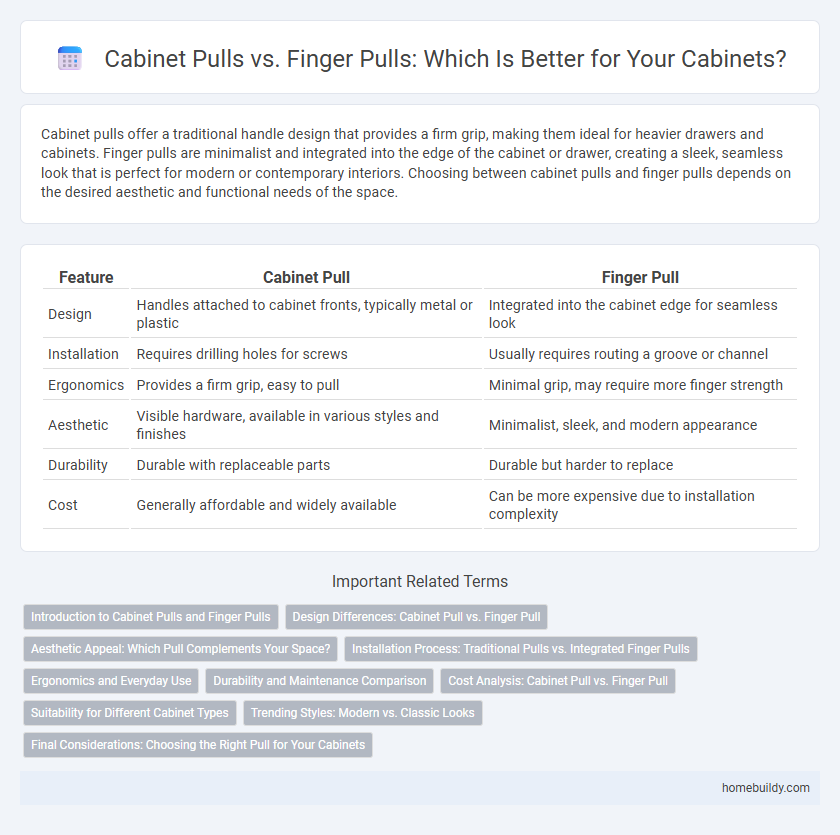Cabinet pulls offer a traditional handle design that provides a firm grip, making them ideal for heavier drawers and cabinets. Finger pulls are minimalist and integrated into the edge of the cabinet or drawer, creating a sleek, seamless look that is perfect for modern or contemporary interiors. Choosing between cabinet pulls and finger pulls depends on the desired aesthetic and functional needs of the space.
Table of Comparison
| Feature | Cabinet Pull | Finger Pull |
|---|---|---|
| Design | Handles attached to cabinet fronts, typically metal or plastic | Integrated into the cabinet edge for seamless look |
| Installation | Requires drilling holes for screws | Usually requires routing a groove or channel |
| Ergonomics | Provides a firm grip, easy to pull | Minimal grip, may require more finger strength |
| Aesthetic | Visible hardware, available in various styles and finishes | Minimalist, sleek, and modern appearance |
| Durability | Durable with replaceable parts | Durable but harder to replace |
| Cost | Generally affordable and widely available | Can be more expensive due to installation complexity |
Introduction to Cabinet Pulls and Finger Pulls
Cabinet pulls and finger pulls are two popular hardware options for cabinet doors and drawers, differing primarily in design and functionality. Cabinet pulls are externally mounted handles offering a firm grip and often available in diverse styles and finishes, enhancing both usability and aesthetic appeal. Finger pulls, by contrast, are recessed into the cabinet surface, providing a sleek, minimalist look while maintaining easy access without protruding hardware.
Design Differences: Cabinet Pull vs. Finger Pull
Cabinet pulls feature a protruding handle for easy grip and a more traditional look, while finger pulls are recessed into the cabinet surface, offering a sleek, minimalist design. The design differences impact both the aesthetic appeal and functionality, with cabinet pulls adding decorative elements and finger pulls creating a seamless, flush appearance. Material choices and shapes vary widely in cabinet pulls, whereas finger pulls often prioritize clean lines and subtle integration.
Aesthetic Appeal: Which Pull Complements Your Space?
Cabinet pulls offer a more pronounced and classic look that enhances traditional and transitional kitchen designs, providing visible hardware that adds texture and depth. Finger pulls, with their minimalist and sleek design, create a seamless and modern aesthetic by blending into the cabinetry for a streamlined appearance. Choosing between cabinet pulls and finger pulls depends on whether you want hardware to stand out as a decorative element or prefer subtlety to maintain clean lines in your space.
Installation Process: Traditional Pulls vs. Integrated Finger Pulls
Cabinet pulls require drilling multiple holes for mounting screws, involving precise measurements to ensure alignment, whereas integrated finger pulls are built into the cabinet design, eliminating the need for additional hardware and simplifying installation. Traditional pulls often demand a screwdriver and template for accurate positioning, while finger pulls are typically part of the molding or edge, reducing labor time and installation errors. Choosing integrated finger pulls can enhance the cabinet's sleek aesthetic by maintaining a seamless surface without protruding handles.
Ergonomics and Everyday Use
Cabinet pulls offer superior ergonomics by providing a full grip surface, reducing strain on fingers and hands during everyday use compared to finger pulls, which require pinching motions that can cause discomfort over time. The larger surface area of cabinet pulls enhances ease of opening heavy or frequently used drawers, making them ideal for kitchens and workspaces where repeated access is essential. Ergonomic designs in cabinet pulls also support users with arthritis or limited hand strength, promoting comfort and reducing fatigue throughout daily activities.
Durability and Maintenance Comparison
Cabinet pulls generally offer greater durability due to their solid metal construction and secure mounting, which withstand frequent use and resist wear over time. Finger pulls, often recessed or integrated into the cabinet surface, can accumulate dirt more easily and require regular cleaning to maintain their appearance. Maintenance for cabinet pulls is typically simpler as they are easier to wipe down and less prone to trapping dust compared to finger pulls.
Cost Analysis: Cabinet Pull vs. Finger Pull
Cabinet pulls generally cost between $3 and $15 per piece, while finger pulls range from $5 to $25, reflecting the difference in materials and design complexity. Installation expenses tend to be higher for cabinet pulls due to necessary drilling and mounting hardware, whereas finger pulls often require minimal modifications, reducing labor costs. Over time, cabinet pulls may incur additional maintenance costs if hardware loosens or tarnishes, in contrast to finger pulls, which have fewer mechanical components and lower upkeep.
Suitability for Different Cabinet Types
Cabinet pulls offer a versatile solution suitable for a wide range of cabinet types, including traditional, shaker, and modern styles, providing an ergonomic grip for easy access. In contrast, finger pulls are best suited for minimalist or contemporary cabinets where a sleek, integrated handle design is preferred, enhancing a smooth surface aesthetic. Choosing between cabinet pulls and finger pulls depends on the cabinet's design, user comfort, and desired visual impact.
Trending Styles: Modern vs. Classic Looks
Cabinet pulls are favored for their sleek, modern appeal and provide a bold statement with clean lines and ergonomic design, enhancing contemporary kitchen aesthetics. Finger pulls offer a classic, minimalist look by allowing seamless integration with cabinet edges for a subtle, understated finish. Modern styles emphasize bold materials like matte black or brushed nickel, while classic designs tend toward polished brass or antique finishes to complement traditional cabinetry.
Final Considerations: Choosing the Right Pull for Your Cabinets
Cabinet pulls offer a traditional grip and ergonomic comfort, ideal for larger drawers and heavy doors, while finger pulls provide a sleek, modern appearance with a minimalist profile, perfect for contemporary designs and smaller spaces. Consider the cabinet style, frequency of use, and ease of cleaning when selecting between cabinet pulls and finger pulls. The right choice enhances both functionality and aesthetic, contributing to the overall kitchen or furniture design harmony.
cabinet pull vs finger pull Infographic

 homebuildy.com
homebuildy.com